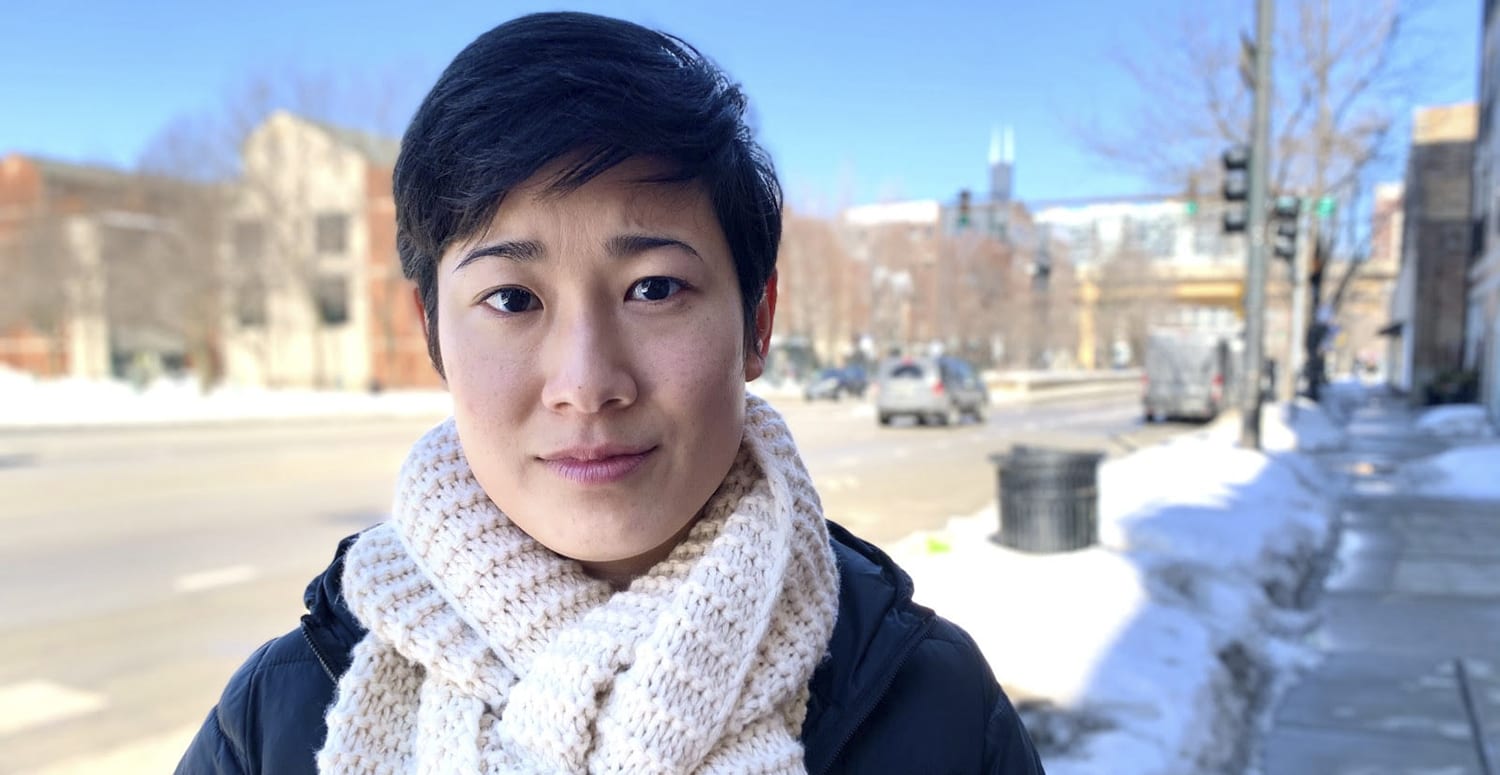
En los últimos meses, Catherine Shieh ha impartido cursos de intervención en Zoom para ayudar a frenar el aumento de agresiones contra asiáticos en todo el país.
Arriba: Catherine Shieh es la coordinadora contra el odio de Asian Americans Advancing Justice Chicago. Esther Yoon-Ji Kang / WBEZ News
Hace tres años, Catherine Shieh estaba en una concurrida estación de tren de Oakland (California) cuando un hombre se le acercó y le pidió un dólar.
Cuando Shieh, estadounidense de origen taiwanés, le dijo que lo sentía y que no llevaba dinero en efectivo, el hombre le dio un puñetazo y la tiró al suelo. Shieh recuerda que levantó los brazos para cubrirse la cara y se hizo un ovillo. Al cabo de un rato, el hombre dejó de atacarla y salió corriendo.
Nadie intervino para atenderla inmediatamente después de la agresión.
La policía encontró más tarde al agresor de Shieh y le dijo que el hombre había estado antes en la cárcel por atacar a mujeres asiáticas y a ancianos.
"Mientras me golpeaban, nadie hacía nada", dijo Shieh. "Corrí a la tienda más cercana ... sólo para tratar de recuperar el aliento, pero realmente me hubiera gustado que alguien hubiera comprobado conmigo de alguna manera".
Shieh, de 28 años y originaria de la zona de San Francisco, se trasladó a Chicago el año pasado. Antigua profesora de instituto, ahora es coordinadora contra el odio de Asian Americans Advancing Justice Chicago.
En los últimos meses, Shieh ha impartido cursos de intervención de transeúntes a través de Zoom, básicamente enseñando a la gente a intervenir de forma segura durante enfrentamientos y ataques como el que ella sufrió. La idea de estos seminarios surgió el año pasado, cuando el entonces presidente Donald Trump y otros líderes empezaron a culpar a la comunidad asiática de la propagación del COVID-19 y se inició una oleada de ataques antiasiáticos en todo el país, incluida la Área de Chicago.
Seguir leyendo
Con la llegada del buen tiempo y un mayor número de personas que se aventuran en espacios públicos, Shieh espera que se produzcan más incidentes de acoso antiasiático en los próximos meses.
"[La formación] ha sido relevante desde febrero de 2020, pero creo que lo que estamos viendo en los medios de comunicación es un aumento de los ataques físicos", dijo Shieh. "En respuesta, hemos visto un enorme repunte en la asistencia a nuestros entrenamientos públicos".
Hace un mes, la asistencia se contaba por decenas. La semana pasada, 130 asistentes participaron en la formación.
Shieh añadió que los seminarios son para todos. "Los espacios públicos no están necesariamente segregados, seguimos yendo al supermercado, paseando, tomando el tren", dijo. "Todo el mundo necesita tomar esto simplemente porque somos miembros públicos de la sociedad".
Aun así, Shieh señaló que muchos de los asistentes han sido mujeres y participantes de color, y que ha sido difícil llegar a los participantes masculinos. "En parte puede deberse a la proximidad con el tema", dijo Shieh, y añadió que las comunidades marginadas suelen tener experiencia de primera mano con el acoso. "Eso no quiere decir que los hombres no sufran acoso o agresiones; también quiero dejarlo claro", dijo.
Shieh explicó que su grupo se asoció el año pasado con la sección de Chicago del Consejo de Relaciones Islámicas Americanas (CAIR), aprendiendo de las experiencias del CAIR después de que los atentados del 11-S desataran una oleada de acoso y políticas públicas antimusulmanas.
"Esencialmente, nos avisaron diciendo: 'Esto es algo que hemos necesitado... tratar continuamente 20 años después'", dijo Shieh.
Los grupos se unieron a la organización sin ánimo de lucro contra el acoso con sede en Nueva York ¡Hola! para desarrollar una formación que ofrezca una breve historia y contexto, ideas tangibles sobre cómo pueden ayudar los transeúntes, además de ensayos de escenarios extraídos de reportajes de la vida real en los medios de comunicación.
Jorge Arteaga, subdirector de Hollaback!, explica que la formación se basa en las cinco D: distraer, delegar, documentar, retrasar y dirigir. La formación ofrece ideas como crear una distracción cuando alguien está siendo acosado, o ponerse en contacto con la víctima justo después para reducir el trauma que ha sufrido.
"Pero hay matices en la forma de utilizar algunas de ellas, y queremos que la gente esté segura cuando utilice las cinco D", dijo Arteaga. "La formación... [ayuda] a personalizar la experiencia como espectador porque hay cosas que tienes que tener en cuenta".
Monica Marcel, que vive en Sauganash, en el extremo noroeste de Chicago, asistió a un curso de formación la semana pasada. Dijo que había visto en los medios de comunicación noticias sobre agresiones a asiáticos, y también había leído en las redes sociales mensajes de amigos asiático-americanos en los que relataban el acoso que habían recibido.
"Estaba buscando algo que pudiera hacer que fuera un poco más proactivo que simplemente asegurarme de que la gente es consciente", dijo Marcel. Encontró en Internet la formación para transeúntes y se inscribió inmediatamente.
Marcel, de 52 años, confía en que cada vez más personas, e incluso empresas. inscríbete para el seminario. Conocer las distintas formas de intervenir y analizar los escenarios reales fue de gran ayuda, dijo. "Eso es a menudo lo que falta: qué se puede hacer y recorrer prácticamente los pros y los contras de cada uno".
Esther Yoon-Ji Kang es periodista de la sección de Raza, Clase y Comunidades de WBEZ. Sígala en Twitter @estheryjkang.

